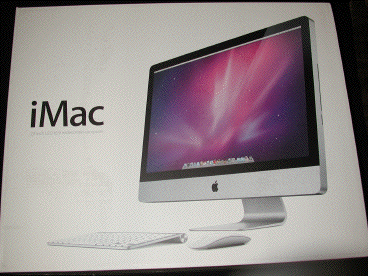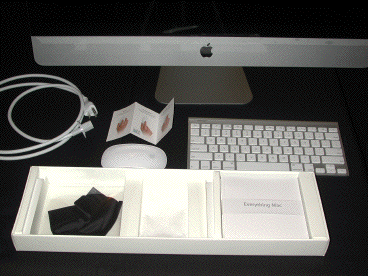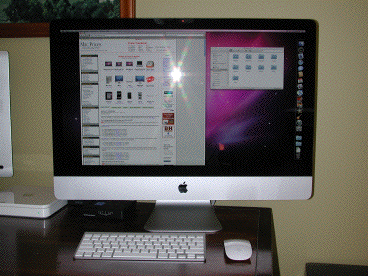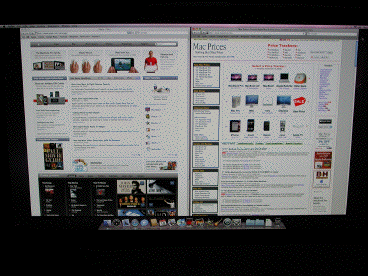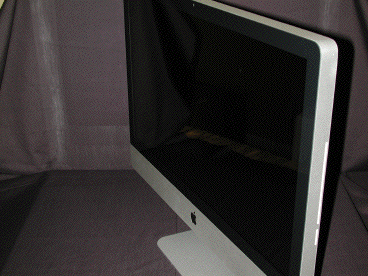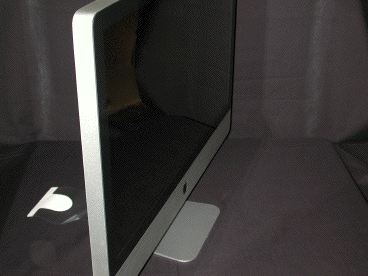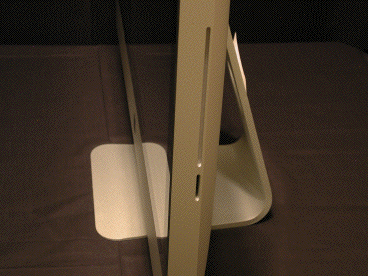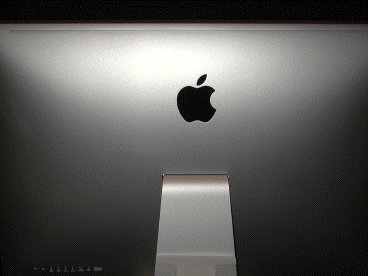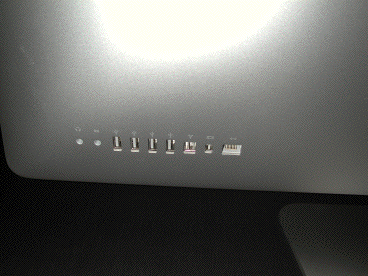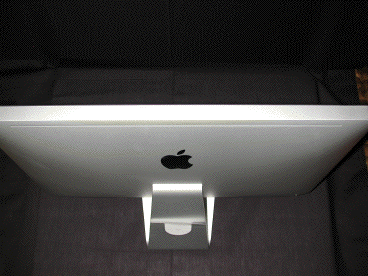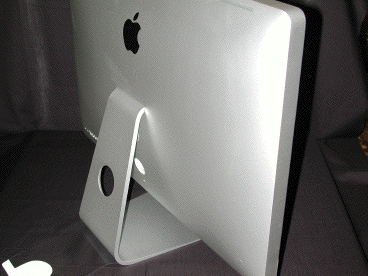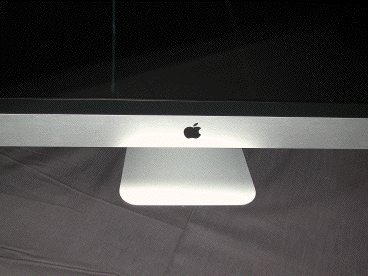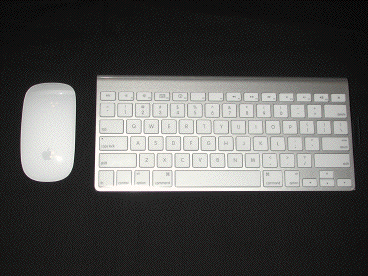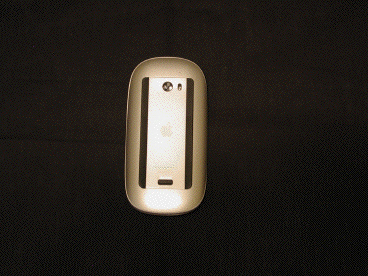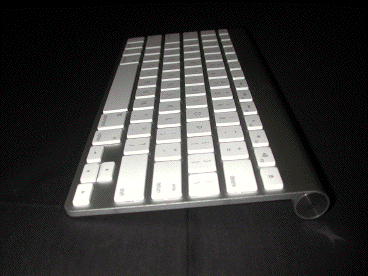Review: 27" iMac
by Charles W. Moore & Steve Hildreth
Steve Jobs unveiled Apple's much-anticipated new "aluminum and glass" iMac line on August 7, 2007 with the most recent update to the line released in May 2011 (introducing Thunderbolt ports and faster Intel Core i5 and i7 processors). The iMac has a slim housing of Apple's signature anodized aluminum along with a glass face, giving it an unmistakably iPhone-ish appearance. The case is made from a single sheet of aluminum, with no seams or screws except for a single compartment on the bottom that provides easy access to the memory slots. The iSight camera and microphone are built-in in a similar manner to Apple's notebooks.
We had a chance to test the 27" iMac. First off, let's just get it out of the way and state that this is a large computer that arrives in a huge box, and it's pretty heavy. Ok, that said, our initial reaction is wow. What a display. In either the 27" model we tested or an available 21.5" display, these iMacs are the first to feature LED-backlit displays with a widescreen 16:9 aspect ratio for HD. While some may not like the glossy external treatment, the new displays feature rich colors and are extremely sharp. We could get lost in them all day.
The base 21" iMac sports a 2.5GHz Intel Core i5 CPU, 4GB RAM, 500GB SATA hard drive, ATI Radeon HD 6750M graphics, and a 8x SuperDrive for $1199. A 21" 2.7GHz i5 CPU model with 4GB RAM, a 1TB SATA hard drive, ATI Radeon HD 6770M graphics, and an 8x SuperDrive sells for $1499. The 27" iMacs start with a 2.7GHz i5 model (4GB/1TB/ATI Radeon HD 6770M) for $1699. The top-of-the-line 27" model features a new 3.1GHz Intel Core i5 Quad-Core CPU (4GB/1TB), ATI Radeon HD 6970M graphics, and a $1999 price tag. A 3.4GHz Quad-Core i7 CPU is a $200 CTO extra.
These models support up to 16GB of installed RAM and up to 2TB internal hard drives.
27" iMacs are the first to offer DisplayPort input, meaning that you can use the iMac as an external display with applicable Mac models with a DisplayPort jack, like the MacBook Pro.
The new Intel Core 2 Duo powered iMacs introduced by Steve Jobs on August 7, 2007 are the fourth generation MacIntel, sixth distinct family and fifth form factor to bear the iMac banner, beginning with the original Bondi Blue 233 MHz G3 iMac in 1998, through a second generation of "teardrop" G3 iMacs, the extremely stylish G4 iMacs with a flatscreen display mounted on an articulated gooseneck arm, the comparatively minimalist G5 iMac, and the original Intel Core Duo iMac which carried over the G5 iMac form factor, and the Core 2 Duo iMac introduced in August, 2006.
The iMac is slim in case section, almost alarmingly so when you consider that all of the works have to be crammed inside that razor-thin housing. At least being elevated in mid-air as it were, the cooling characteristics are more efficient than with a notebook computer.
Our initial and so far abiding impression was that Apple was unmistakably going for an iPhone-ish look, and it does work, although not as convincingly as on the iPhone itself...However, there is more here than just styling as with all good design. The iMac's case is made from a single sheet of aluminum, with no seams or screws except for a single compartment on the bottom that provides easy access to the memory slots.
The iMac line comes with an Apple Wireless Keyboard, Wireless Magic Mouse, built-in iSight video camera for video conferencing and iLife, including iTunes, iPhoto, iMovie, iDVD, iWeb, GarageBand, plus Front Row, Photo Booth, and a 30-day trial version of iWork. The latter is a bit cheesy, when you recall that Apple used to ship AppleWorks for free with its pre-Intel consumer models.
Alas, there is no internal modem, so if you live beyond the reach of broadband, you'll need to pony up another 50 bucks for Apple's external USB Modem. The 21" iMac weighs 20.5 pounds, while the 27" iMac, like we mentioned earlier, is a beast at 30.5 pounds.
Both iMac models come with a built-in iSight video camera, built-in 10/100/1000 BASE-T Gigabit Ethernet, built-in AirPort Extreme, four USB 2. ports, and one FireWire 800 port. Picking up on the theme started by the last MacBook Pro update, the new iMacs sport an SD card slot on the side just below the optical drive.
With the available Quad-Core model, fast ATI graphics, and 7200RPM hard drives, the new iMac moves closer to the Mac Pro in raw computing power, sometimes even exceeding the Mac Pro, and much farther away from the Mac mini. Indeed, the new 27" iMac would make a good sustitute for a low-end Mac Pro except for its lack of expansion abilities.
Quad-Core iMacs will score even hgher. The large display and fast ATI graphics make the iMac ideal for games and video work. Second Life, for example, is big and bold on the 27" display, and with a fast internet connection, rezzing is minimal.
The new Magic Mouse, while maybe not the most ergonomic mouse on the market, nevertheless makes activities like web surfing a breeze. The ability to scroll down the page and flip back and forth between pages without moving the mouse is a real joy. On the downside, when using Google Earth or Google Maps, we found that it was too easy to mistakenly zoom in and out when all we wanted to do was click the mouse and move around the maps.
View a short walk-through of the 27" iMac:
If you're in the market for a desktop Mac and on a budget, you can't beat the iMac for value. While the Mac mini has a lower sticker price, you don't get a whole lot with it - just a slower Core 2 Duo CPU, no keyboard, no mouse, no display, a generally inferior architecture. The iMac has a 3.5" 7200 RPM desktop hard drive and an 8x SuperDrive standard. Not to mention a drop-dead gorgeous display. It's not hard to divine where the value lies in this saw-off. The amount of standard bells and whistles and bundled software, plus a built-in widescreen display make the iMac, whichever model you choose, and awesome deal. The biggest knock against the iMac is its limited expandability, but an awful lot of Mac users never upgrade from the hardware configuration that their computer ships with, and if they do, it's usually RAM, for which the iMac has ample headroom for most of us.
